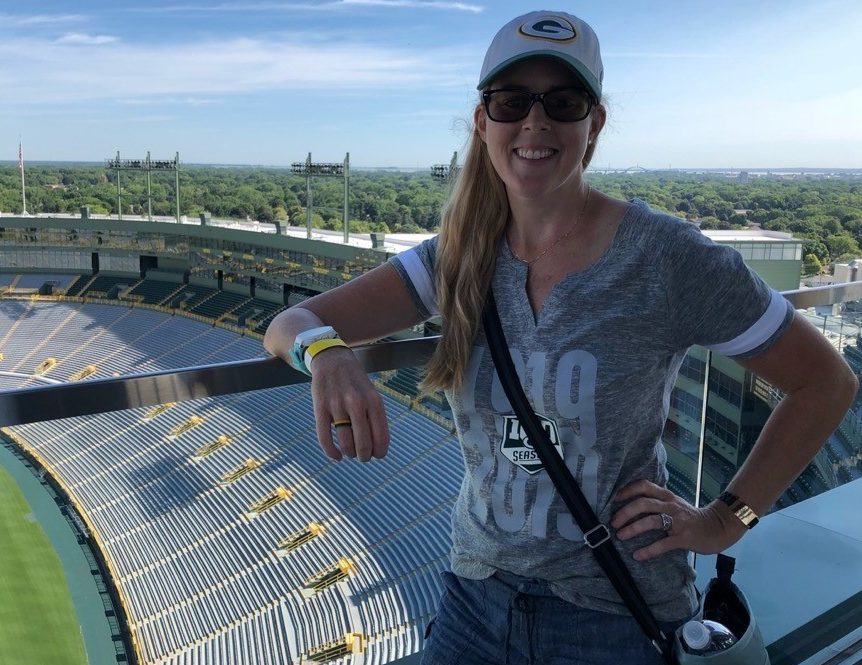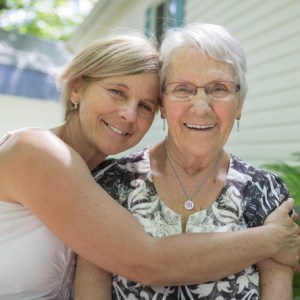I’ll be a MedicAlert member for the rest of my life. MedicAlert means I can live the life I want to live. A full life. A life I love.
Sarah, MedicAlert Member since 1999
Food Allergies, Anaphylaxis and Running
Food allergies affect an estimated 2.5% of the global population. Of the 198.5 million people around the world living with food allergies, approximately 20 million people in the U.S. live with the condition. This includes 5.6 million children under the age of 18.
“I had my first anaphylactic shock reaction in 1989, a couple months before my 9th birthday,” says Sarah. “I arrived at the hospital in time to receive epinephrine and thankfully I survived. Allergy tests would reveal food allergies. I was allergic to all seafood and fish, though I’d eaten them without incident nearly every week for my entire life up to that point.”
“My second anaphylactic reaction was to chicken when I was 10. Again, I arrived at the hospital quickly, and epinephrine again saved my life. I went to the allergist again for more tests and found I had to add poultry and tree nuts to my allergy list. It was at this allergist visit that my mom was given a MedicAlert brochure. She signed me up immediately, and my first bracelet soon came in the mail.

A childhood with anaphylaxis food allergies
Every three minutes, a food allergy sends someone to the emergency room. In the U.S. and around the world, many of the same foods are responsible for the most allergic reactions. Examples include peanuts, eggs, fish, crustacean shellfish, tree nuts, and milk, with peanuts causing the most anaphylactic reactions.
Even the smallest amount of these foods can cause anaphylaxis, which is an acute allergic reaction to an antigen such as foods, medicines, and insect bites.
“I was teased some at school for wearing my MedicAlert ID,” says Sarah. “In 1990 food allergies weren’t that common, and the only people I saw with MedicAlert bracelets were of my grandparents’ generation. Kids said I was a grandma/grandpa, but I kept wearing my “grandma” bracelet because my mom said I couldn’t take it off!”
“I had another anaphylactic reaction when I was 11 while at a youth group BBQ. I inadvertently had a bite of a turkey hot dog,” Sarah explains. “My youth pastor rushed me to the hospital, and epinephrine saved my life yet again. Doctors used the info on my MedicAlert bracelet to contact my parents and allergist.”
“A lot of people don’t know that an anaphylactic reaction always requires an emergency room visit,” says Sarah. “Without the proper treatment, anaphylaxis can turn deadly in a little as 15 minutes.”
Want to learn more?
About Food Allergies
Learn more about this condition on the medical conditions page.
Read More >
Other Conditions
Read about other conditions that our MedicAlert members live with.
Read More >
Anaphylaxis symptoms and MedicAlert.
The first signs of anaphylaxis may include hives, itching, and flushed or pale skin. This can quickly progress to throat swelling, low blood pressure, and difficulty breathing. Shock can occur. Even worse, anaphylaxis symptoms can return within 6-12 hours after an epinephrine injection. In some cases, symptoms can return days later.
“Even if you receive epinephrine right away,” says Sarah, “you still need to be observed by medical professionals to ensure you recover completely.”
According to the American College of Allergy, Asthma, & Immunology (ACAAI), a delay in using epinephrine is common in severe food allergic reaction deaths. A MedicAlert food allergy bracelet can save precious time by alerting first responders and those around you that you have food allergies and carry an EpiPen (epinephrine auto-injector). Having this information readily available can help save your life if you are in an accident or have another medical emergency.
An accident or dangerous allergic reaction can occur at work, at school, at home, or on the run. A MedicAlert food allergy bracelet can be there for you every second of every day, protecting you no matter where you are or what you do.
My husband and daughter feel more at ease when I go out for a race or training run knowing MedicAlert will help protect me, and notify them in an emergency.

Facts About Food Allergies
Anaphylaxis symptoms and MedicAlert.
The first signs of anaphylaxis may include hives, itching, and flushed or pale skin. This can quickly progress to throat swelling, low blood pressure, and difficulty breathing. Shock can occur. Even worse, anaphylaxis symptoms can return within 6-12 hours after an epinephrine injection. In some cases, symptoms can return days later.
“Even if you receive epinephrine right away,” says Sarah, “you still need to be observed by medical professionals to ensure you recover completely.”
According to the American College of Allergy, Asthma, & Immunology (ACAAI), a delay in using epinephrine is common in severe food allergic reaction deaths. A MedicAlert food allergy bracelet can save precious time by alerting first responders and those around you that you have food allergies and carry an EpiPen (epinephrine auto-injector). Having this information readily available can help save your life if you are in an accident or have another medical emergency.
An accident or dangerous allergic reaction can occur at work, at school, at home, or on the run. A MedicAlert food allergy bracelet can be there for you every second of every day, protecting you no matter where you are or what you do.
Anaphylaxis and EpiPen use
Epinephrine (adrenaline) is the first-line treatment for anaphylaxis. Epinephrine works by reversing the life-threatening symptoms associated with this reaction. “Allergists advise that all patients who have food allergies carry their EpiPen with them at all times,” reports the ACAAI. This is crucial for individuals who have had a previous anaphylactic reaction, those living with both food allergies and asthma, and anyone with peanut, tree nut, fish, or crustacean shellfish allergies.
“After multiple episodes of anaphylactic shock,” says Sarah, “I finally started carrying an EpiPen so I could inject myself with epinephrine if I was exposed to an allergen. My parents stood up for me by petitioning the school board, and the board granted me permission to keep my EpiPen in my backpack,” Sarah says.
Today, just about every state in the U.S. has epinephrine stocking laws or regulations in K-12 schools, with multiple states requiring stocking in schools. In 2003 alone, doctors prescribed 1.4 million EpiPens. By 2007, that number had reached 1.9 million — a staggering 36% increase. In 2015, the number of EpiPens prescribed stood at approximately 2.5 million.
“Since then [junior high], I’ve added many more foods to my “death” list,” says Sarah. “Currently, there are 22 foods/food groups I can’t eat. The risk is that I could go into anaphylactic shock, which can be fatal if not treated immediately. Fortunately, I can now eat shrimp and salmon after successfully completing food challenges!”
I’ve survived anaphylactic shock many times, and a MedicAlert bracelet has been with me nearly every day since I was 10.

“My most memorable race was the 2019 Surfer’s Path Marathon. The forecast called for electrical storms and overall unpleasant weather. I was nervous I’d be miserable for the whole race. For the first 10 miles there was torrential rain, hail, lightning, and thunder,” Sarah explains. “Then the sun made an appearance over the Pacific Ocean and I was determined to do my best. Even with all the crazy weather, I managed to earn a PR (personal record)! “My husband and daughter feel more at ease when I go out for a race or training run knowing MedicAlert will help protect me, and notify them in an emergency.”
MedicAlert protection plans and managing food allergies
A MedicAlert protection plan adds an extra layer of protection to food allergy care plans. Our protection plans can deliver detailed information about your condition directly to ER personnel. This ensures that your ER team knows you are living with dangerous food allergies, so the most accurate treatments can be administered quickly and safely. In addition, a MedicAlert protection plan can deliver your full health profile, designated physician’s information, and emergency contact information directly to ER teams. With a MedicAlert food allergy bracelet and protection plan, you will always have a voice.
“I live with life threatening food allergies and the risk of anaphylaxis,” says Sarah. “Having a MedicAlert ID allows me to live the life I want to live. A full life. A life I love.”
Food allergies and anaphylaxis: educating the next generation.
Organizations such as the Asthma and Allergy Foundation of America (AAFA) help educate, advocate, and raise awareness for people affected by life-threatening allergies. As individuals, we can also do our part to educate those around us about the dangers of food allergies.
“I’ve been a primary teacher for 16 years (most of my experience is in kindergarten and first grade),” says Sarah. “At the beginning of each new school year, I share my story with my students, including my bracelet and EpiPen [use], and explain what to do in case of a severe allergic reaction.”
“Throughout the year,” she says, “they remind me to get my “medicine” when we walk out to recess! But it’s a great way to educate them about food allergies and what to do in an anaphylactic emergency. It helps them understand that anyone can have food allergies, and it’s nothing to be ashamed of. I show them that with the right precautions (like MedicAlert) they can live a normal, active life.”
“I’ll be a MedicAlert member for the rest of my life,” Sarah says. “I love my MedicAlert bracelet!”



